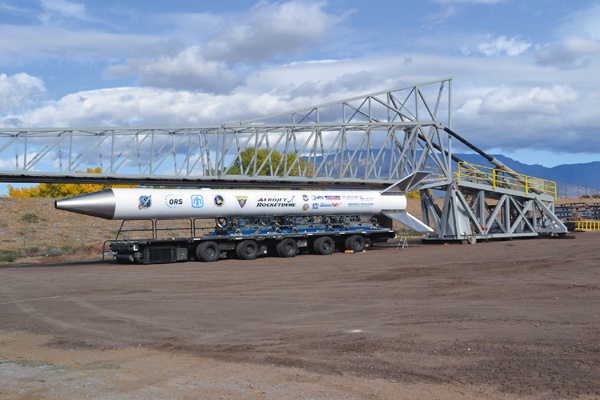LIHUE — The 135-foot rail launcher to be used in Hawaii’s first space launch, known as ORS-4, was unveiled Monday at the National Technical Systems facility in Albuquerque, N.M. The launcher was built by NTS and Western Fabrication. It will
LIHUE — The 135-foot rail launcher to be used in Hawaii’s first space launch, known as ORS-4, was unveiled Monday at the National Technical Systems facility in Albuquerque, N.M.
The launcher was built by NTS and Western Fabrication. It will now be disassembled and moved to the Pacific Missile Range Facility, where it will be reassembled for the 2014 launch.
“It’s a huge deal for us and this is another step toward finally achieving the long-planned launch from here,” PMRF Public Affairs Officer Stefan Alford wrote in an email. “But even more so for the University of Hawaii and NASA partnership — as always, we provide the location but it’s the customer’s programs we allow to execute using our range.
In addition, a full-sized model of the Super Strypi rocket that will be used in the Hawaii launch was unveiled.
The mission manager for the launch is the Air Force’s Operationally Responsive Space Office. The open house event Monday was hosted by ORS and project partners Sandia National Laboratories, the PMRF on Kauai, Aerojet Rocketdyne Corp. and UH’s space flight laboratory.
The launch is currently planned for spring 2014.
The ORS-4 mission is sponsored by the ORS Office and is the first launch of the Super Strypi launch system. This mission will demonstrate a new, low-cost launch capability able to deliver 300 kilograms to Low-Earth Orbit. This is the first orbital launch from the PMRF and will enable low-cost launch alternatives and range processes for the future.
When the Super Strypi rocket takes flight from the U.S. Navy’s PMRF, it will be carrying a satellite designed and built by UH students. UH will have also played a significant role in getting the satellite into space. With this mission, UH has become one of the only universities in the world to have both satellite fabrication capabilities and direct access to orbital space.
“The University of Hawaii is pleased to support the state in becoming a low-cost gateway to space and to provide our students with real-world experience that will be invaluable as we train Hawaii’s aerospace workforce,” Interim President David Lassner said.



